The bulk of the paintings in the Luís de Camões Museum collection are the works of Guangdong· painters. Only about twenty percent of the paintings are by artists from other provinces; this group, for the purpose of discussion, can be further broken down into three classifications: paintings by loyalists of the Late Ming· dynasty; Shanghai· artists of the late Qing; · and a miscellaneous group.
THE LATE MING LOYALISTS
The Ming dynasty came to an end in 1644 with the suicide of the Ming emperor, Chongzheng, · in Beijing, ·but the struggle between the descendants of the Ming royal family and the Qing dynasty continued for the next twenty years. Historians refer to this period as the period of the Southern Ming, when Guangdong and Guangxi provinces were strongholds of the southern government. A number of Guangdong painters were deeply involved in this struggle, but unfortunately none of their paintings is preserved in the Luís de Camões Museum. There are, however, three paintings represented who were late Ming loyalists from other parts of China, and they form a small but significant group within the Museum collection.
Bada Shanren· (°ca1626-†ca1708), originally known as Zhu Da, ·was one of the loyalist group. Born in Nanchang, Jiangxi province, of an aristocratic family that was descended from Ming royalty, he fled home after the emperor's suicide, shaved his head, changed his name, and became a Buddhist monk. Later on he grew back his hair and turned to the Daoist priesthood, but he retained the name Bada Shanren which he had adopted from his exile.
Bada Shanren apparently took up painting only after his exile and conversion. His art is really the result of his own untiring studies coupled with the sublimation of his deep emotion. His brushwork and ink control, while careful and creative, are not particularly successful. The extremely heavy brush strokes that distinguish his paintings are meant to convey the anguish and remorse of the exile who has lost his country and is helpless to regain it. Animals & fish, ducks and geese & were among his favourite subjects through which he expresses human emotions, as in "Guyan tu"· ("A Solitary Goose") [Plate 14] in the Luís de Camões Museum, in which the goose, with its comical posture and heavy sad eyes, expresses vividly a feeling of homelessness.
Eighteenth-century art historians were aware of Bada Shanren achievement, but there has been little agreement about his chronology. There seem to be three different theories:
a) that he was born in 1624 and died in 1705; 1
b) that he was born in 1625 and died at about eighty & i. e., around 1704; 2 and finally,
c) according to Xie Zhiliu, • he was born in 1626, and died some years after he reached eighty. 3
Zhou Shixin, • a recent scholar, follows this last theory, and in his Bada Shanren niapu• (Chronology of Bada Shanren), puts the artist's dates as 1626 to 1708. 4 By this chronology, since the date inscribed on "A Solitary Goose" is dingmao• or 1687-1688, the painting was painted when the artist was sixty-two. Now this conclusion is consistent with the findings of the studies of Xie Zhiliu• and Wang Fanyu on the artist's signature. They observed that the character 'ba' in his name was written as 'A' before his seventieth birthday (1695, according to the last chronology). Later he represented the character with two dots. 5 The inscription on "A Solitary Goose" is written in the earlier style. This agreement renders it unquestionable, if we accept Xie Zhiliu's theory, that the painting is authentic, and if so, then it is a valuable find indeed, as so few works of the artist have survived.
Wan Shouqi• (°1603-†1652), another late Ming loyalist, is represented in the Luís de Camões Museum collection with "Muyang tu"• ("A Shepherd and His Sheep"). [Plate 15] A native of Jiangsu• province, Wan was also known under his various tzu: • Jieruo, • Iyizi, • and Nian Shao. • Like a number of others who went to the official examination in Nanjing• in 1630, which he passed, Wan Shouqi had become deeply involved with the influential movement known as 'Fushe' • ('Restoring the Empire'), the reformist literary organization that criticized the government. Many of the members of this group were killed in the battle with the Qing army in Nanjing, in 1645. Wan Shouqi himself barely escaped, whereupon he gave up politics and became a Buddhist monk.
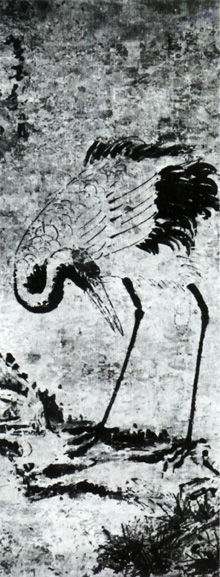 Illustration 30
Crane and Pines 松鹤图.
FU SHAN 傅山(o1607-†1684). Original name DING CHEN 鼎臣, tzu QING ZHU 青主, YANG QU 阳曲 or TAIYUAN
太原.
Hanging scroll.
Slight colour on paper, 101.3 x 45.2 cm. Dated 1633. Signed with 1 seal.
[Former] registration number: A2. In: [SC: OPLCM, M], p.61, FU SHAN ref. no1 [plate 45].
Illustration 30
Crane and Pines 松鹤图.
FU SHAN 傅山(o1607-†1684). Original name DING CHEN 鼎臣, tzu QING ZHU 青主, YANG QU 阳曲 or TAIYUAN
太原.
Hanging scroll.
Slight colour on paper, 101.3 x 45.2 cm. Dated 1633. Signed with 1 seal.
[Former] registration number: A2. In: [SC: OPLCM, M], p.61, FU SHAN ref. no1 [plate 45].
A skilled seal carver, 6 an expert swordsman, 7 an accomplished musician, a connoisseur of the antique ink-sticks, Wan Shouqi was also a gifted poet and painter. An anthology of his poems Shixi caotang shiji• (A Collection of Poems from the Shiji caotang), is still read and studied, but his paintings are very rare. About ten of his paintings are known today, 9 among them the "Shepherd and His Sheep" in the Luis de Camões Museum. The painting shows a Buddhist monk with a lingzhi• branch in his right hand and a bamboo pole in his left. On his back is a woven rain garment and a gourd is tied to his waist. Wearing grass sandals, he stands, upright and alone, in front of a cliff. Beside him roam three sheep. The significance of the composition is not known, but the drapery folds, rendered in combination of yousimiao• (lines like long, loose strands of a spider's web) and zhelumiao• (lines like broken reed) lend an archaich atmosphere to the picture. The fact that he used the same yousimiao in both his "Zihuaxiang" • ("Self Portrait")10 and his "Shepherd and His Sheep", may be a clue to the symbolic significance of the painting.
The third painting of this group in the Luis de Camões Museum is "Songhe tu"• ("Crane and Pines") [Illus.30] by Fu Shan.· (°1607-†1684). Bada Shanren and Wan Shouqi were both southern painters of the Yangzi• (Pearl) River area, but Fu Shan, a native of Taiyuan• in Shansi, • was a typical northern painter of the area around the Huang Ho• (Yellow River). After the suicide of the last Ming emperor, he became a Daoist priest and withdrew into seclusion, first to a cave and later to a small house in Taiyuan. He travelled to Yuguan• in Beijing, • in June 1654, and there he was arrested and put in jail for being an accomplice of the Southern Ming, and was not released until the following year.
 Illustration 31
Willow and Egret Under the Moon 月下枊鹭-
REN BONIAN 任伯年 (°1840-†1896).
tzu BO NIAN 伯年, hao XIAO SHAN 萧山.
Hanging scroll.
Colour on silk, 161.0 x 40.0 cm.
Signed with 1 seal. [Former] registration number: A28.
In: [SC: OPLCM, M], p.63, JEN I ref. no1[plate 46].
Illustration 31
Willow and Egret Under the Moon 月下枊鹭-
REN BONIAN 任伯年 (°1840-†1896).
tzu BO NIAN 伯年, hao XIAO SHAN 萧山.
Hanging scroll.
Colour on silk, 161.0 x 40.0 cm.
Signed with 1 seal. [Former] registration number: A28.
In: [SC: OPLCM, M], p.63, JEN I ref. no1[plate 46].
The surviving works of Fu Shan are even rarer than those of Bada Shanren and Wan Shouqin. "Cranes and Pines" is one of the few that are dated, but unfortunately, because of the decayed condition of the paper, the characters are almost unreadable. If, as seems likely, the inscription refers to the cyclical year guiyou, • the picture would have been painted in 1633-1634 when the artist was only twenty-six years old," and, judging from the shapes of the lines and the ink wash technique, the work is most likely a finger painting. If these two conjectures are indeed correct, then this painting would be even more valuable for the study of Fu Shan's works.
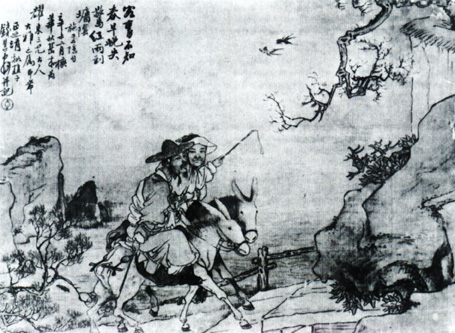 Illustration 32
Figures in the Style of Hua Yan X华X人物.
QIAN HUIAN 钱慧安 (Early nineteenth century).
Original name GUI CHANG 贵昌, tzu JI SHENG 吉生, hao QING XI 清谿.
Album leaf.
Colour on silk, 30.3 x 41.9 cm.
Dated 1871. Inscribed and signed with 1 seal.
[Former] registration number: AL5-4.
In: [SC: OPLCM, M], p.60, CH'IEN HUI-AN ref. no 2 [plate 47].
Illustration 32
Figures in the Style of Hua Yan X华X人物.
QIAN HUIAN 钱慧安 (Early nineteenth century).
Original name GUI CHANG 贵昌, tzu JI SHENG 吉生, hao QING XI 清谿.
Album leaf.
Colour on silk, 30.3 x 41.9 cm.
Dated 1871. Inscribed and signed with 1 seal.
[Former] registration number: AL5-4.
In: [SC: OPLCM, M], p.60, CH'IEN HUI-AN ref. no 2 [plate 47].
In conclusion, although only three of the paintings by Late Ming loyalists are collected in the Luis de Camões Museum, this is nonetheless an important collection, since paintings by Zhu Da, Wan Shouqi and Fu Shan are extremely hard to come by.
THE SHANGHAI SCHOOL IN THE LATE QING
The Shanghai School, established in the nineteenth century, was a late development in the history of Chinese painting, but in the latter half of the century, under the impetus of southern painters who had been driven north by the Taiping• rebellion, Shanghai became a flourishing centre of activity and contributed significantly to the development of modern Chinese painting. During this time, a number of societies were formed by artists to study painting and calligraphy. 12 This brought about the apex of activities of the Shanghai School.
The most successful painters in late Qing Shanghai were the two 'Rens' - Ren Fuchang• and Ren Bonian. • Their style, derived from Chen Hongshou, • a Zhejiang• painter of the late Ming, gives a first impression of being archaich, but shows upon more careful study a pretentiousness resulting precisely from the fastidious efforts to be archaich. Their paintings were, however, extremely popular in Shanghai and its neighbourhood.
 Illustration 33
Pine and Plum Blossoms 松梅双清图.
HU GONGSHOU胡公寿(o1823-†1886).
tzu GONGSHOU公寿.
Hanging scroll.
Colour on paper, 241.0 x 60.0 cm.
Dated 1868. Inscribed and signed with 2 seals.
[Former] registration number: A213.
In: [SC: OPLCM, M], p.62, HU YÜAN ref. no 2 [plate 48].
Illustration 33
Pine and Plum Blossoms 松梅双清图.
HU GONGSHOU胡公寿(o1823-†1886).
tzu GONGSHOU公寿.
Hanging scroll.
Colour on paper, 241.0 x 60.0 cm.
Dated 1868. Inscribed and signed with 2 seals.
[Former] registration number: A213.
In: [SC: OPLCM, M], p.62, HU YÜAN ref. no 2 [plate 48].
Ren Bonian, originally from Zhejiang, probably came to Shanghai as early as 1856, 13 and stayed in Shanghai for the rest of his life, which was some fifty years or so. By 1856, when Ren Bonian first arrived, Ren Fuchang was already a celebrated painter. Bonian followed and developed on Fuchang style as well as built on his reputation, and came to be widely acclaimed.
In the Luís de Camões Museum collection there are two bird-and-flower hanging scrools by Ren Bonian, "Zhushi zhegu"• ("Squab, Bamboo and Rock") and "Yuexia liulu"• ("Willow and Egret Under the Moon"). [Illus.31] Unfortunately neither of these works is dated. The "Willow and Egret [...]" painting, rendered with a combination of gongbi and xieyi• techniques, shows great dexterity, and is quite exquisite.
Such was the background of the Shanghai art world against which Qian Huian• (°1833), originally from Suzhou• in Jiangsu, • and one of the most important painters of the late nineteenth-century Shanghai, had to struggle. Competition with the 'two Rens' was difficult. It seems like that, like his fellow professional painters who lived on selling their work, Qian Huian was confronted with this dilemma: while competition with the 'two Rens' on their own grounds was certain defeat, to develop an independent style hardly promised success. However, Qian Huian solved the problem and succeeded in establishing a name for himself by cultivating different grounds, so to speak. He concentrated on figure painting. He would often give a simple landscape as background to his figures, but true landscape painting or bird-flower painting he rarely attempted. In this way he avoided the stiff competition with the 'two Rens' and even became friends with them.
In style, Qian Huian drew upon the works of two earlier painters, Gai Qi• and Hua Yan. • His style is a synthesis of theirs. Stylistically, Hua Yan's paintings are simple and easy to accept, and Gai Qi's are light and soft, almost feminine. Qian Huian combined them to create a new style of popular subjects rendered with a simple, light ink brushwork that was highly decorative. With this new style he gained a place in Shanghai art world, and flourished beside the 'two Rens' with their reminiscence of archaic beauty.
The collection of the Luis de Camões Museum includes three items: a fan painting and two album leaves which are relatively unimportant nonetheless representative of this important painter. The fan, titled "Fu Tang Yin" • ("Figures in the Style of Tang Yin"), and one of the album leaves, "Fu Hua Yan" • ("Figures in the Style of Hua Yan"), are both dated 1871 [Ilus.32]; the other album leaf, "Fang Chenbayiyang" • ("In the Style of Chen Chun") is dated 1889.
Besides Ren Bonian and Qian Huian, two other painters of the Shanghai School are represented in the Luís de Camões Museum; they are Hu Gongshou• and Hu Zhang.· Before discussing either of them, it is worth mentioning that the Shanghai School was also an important stimulus in the development of Japanese painting during the Meiji period [1868-18889]. Japanese literati such as Yasuda Lo-jin• (°1830-†l895) and Murada Kashiya• (°1828-†l912) had studied with the outstanding Shanghai painter Hu Gongshou, who was highly acclaimed in Japan.
 Illustration 34
Eagles and Pines 劲翮凌风.
HU ZHANG胡璋(o1848).
tzu TIE MEI 铁梅, hao TONG CHENG 桐城.
Hanging scroll.
Colour on paper, 180.5 x 47.0 cm. Inscribed and signed with 1 seal. [Former] registration number: A214.
In: [SC-.OPLCM. M], p.33, HU CHANG ref. no1 [plate 49].
Illustration 34
Eagles and Pines 劲翮凌风.
HU ZHANG胡璋(o1848).
tzu TIE MEI 铁梅, hao TONG CHENG 桐城.
Hanging scroll.
Colour on paper, 180.5 x 47.0 cm. Inscribed and signed with 1 seal. [Former] registration number: A214.
In: [SC-.OPLCM. M], p.33, HU CHANG ref. no1 [plate 49].
Hu Gongshou, • born in 1832, was a native of Huating, • in Jiangsu province, near Shanghai. His original name was Hu Yuan, • Gongshu was really his tzu, but this name together with his style names Xiao Qiao• and Hengyun Shanren• were little known. According to Wan Tao, · the scholar whose notes on Shanghai, Yingchang zazhi• (Notes on the City of Shanghai) (six juan) [six volumes], was published in 1862, Hu Gongshou was renowned for his poetry and calligraphy as well as for his painting. Wan Tao reported that he was a particularly accomplished landscape painter, although he did not, in fact, produce many landscapes. Actually Hu Gongshou was not only accomplished in landscape painting; according to the scholar Zhang Mingke, • author of a book about painting called Hansongge tanyi• suolu (Hansongge's Essays on Art), Hu Gongshou was good at flower paintings no less than at landscapes. He had a special preference for painting plum blossoms, and Zhang Mingke described his plum blossom paintings as "Old luxuriant branches laid horizontally across the screen: facing it is like living in a cottage on a lonely hill."
Both aspects of Hu Gongshou art, together with his calligraphy, are represented in the Luis de Camoes Museum. There are two items. "Songmei shuagqing" • ("Pine and Plum Blossoms") [Illus. 33], is a large hanging scroll with an inscribed poem, which gives a glimpse of the artist's calligraphy although does not do justice to his poetry. This bold and virile composition was painted when the artist was forty-five years old, at the peak of his energy. In that same year Hu Gongshou also painted "Taohuajian tu"• ("Taohua Brook"), in the Luis de Camões Museum collection, but as a fan painting, it is a minor work and not to be considered in the same class with the "Pine and Plum Blossoms" scroll.
Hu Zhang; • somewhat younger than both Hongshou and Qian Huian, was born in 1848 in Tongcheng, • a literary centre of Anhui• province. His father, Hu Yin, • had been prefect of the district, but gave up the official life to make a living as a painter. Hu Zhang, following in his father's footsteps, became an artist of some renown before moving to Shanghai where he married a Japanese woman. Later he travelled in Japan. Hu Zhang, like the earlier Hu Gongshou, was apparently held in much greater esteem in Japan than he was in his native China, and his works are considered significant in the development of modem Japanese ink monochrome. His "Jinhue lingfeng"• ("Eagles and Pines") [Illus.34] in the Luís de Camões Museum collection is an over-sized hanging scroll, typical of the Shanghai School. It is a powerful and impressive painting, with firm, clear brushwork, and the imposing old pine tree is fully as elegant as the one in Hu Gongshou's "Pine and Plum Blossoms".
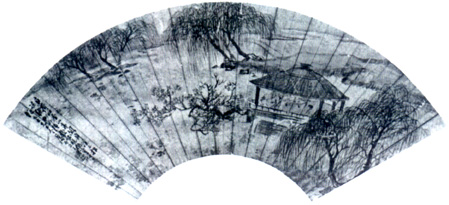
Illustration 35
Enjoying the Breeze Under the Willows 枊荷招凉图.
BAO DONG 包栋 (active mid nineteenth century).
tzu ZI LIANG 子梁.
Fan.
Colour on paper, 37.0 x 46.0 cm.
Inscribed and signed with 1 seal.
[Former] registration number: AL7-5.
In: [SC-.OPLCM. M], P-64, PAO TUNG ref. no1 [plate 50].
Two other pictures from the Shanghai School in the Luís de Camões Museum collection deserve notice. Bao Dong's• "Liuhe zhaoliang tu"• ("Enjoying the Breeze Under the Willows") [Illus. 35] is a landscape painted on a fan. Executed with a small brush, it shows little dexterity an in fact bear no relationship to the highly regarded figure paintings of this artist that were described by Zhang Mingke in his Hansongge tanyi suolu. "Douji tu"• ("Two Cocks") [Illus.36] by Jin Yuan· also contradicts what has been written elsewhere about this painter. Jin Yuan has been called a refined and elegant stylist, yet "Two Cocks" is painted in a bold, rough manner that is not lacking in vitality. It was painted in 1864, probably when Jin Yuan was serving a term of office in the prefecture of Haiyang, • in Guangdong.
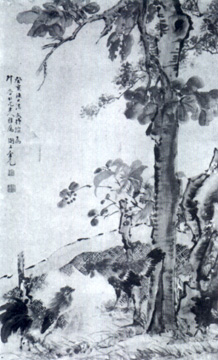
Illustration 36
Two Cocks 斗鸡图.
JIN YUAN 金元 (active late nineteenth century).
tzu WEN YU 问渔.
Hanging scroll.
Colour on paper, 85.2 x 50.7 cm.
Dated 1863. Inscribed and signed with 2 seals.)
[Former] registration number: A41.
In: [SC: OPLCM, M], p.60, CHIN YUAN ref. no1 [plate 51].
There are a number of other paintings of the late Qing dynasty Shanghai School in the Luis de Camões Museum, such as the fan paintings of Yang Nianbo• and Zhang Baosheng, • too many for discussion in a paper of this nature. While the collection is by no means complete, it could serve as a nucleous for future expansion, should this become possible.
MISCELLANEOUS PAINTINGS IN THE LUIS DE CAMOES MUSEUM

Illustration 37 Landscape & A Pictorial Rendition of a Tang Poem
唐人诗意图.
WANG PU王溥 (active mid nineteenth century).
tzu YUN QUAN 云泉
Hanging scroll.
Ink on paper, 165.7 x 45.3 cm.
Dated 1813. Inscribed and signed with 3 seals.
[Former] registration number: A242.
In: [SC: OPLCM, M], p.65, WANG P'U ref. no1 [plate 53].
Because of their diverse nature, it is difficult to classify the remaining paintings in the Luis de Camões Museum collection. The following are among the most important:
"Shenyin caicha tu"• ("Picking Tea Leaves in the Mountains") [Plate 16] by Huang Shen. • A Fujian• painter, Huang Shen was considered an important artist by Guangdong collectors in the mid-nineteenth century. It seems likely that this large scroll was brought into Guangdong at the time. 14 The powerful and expressive brushwork makes it a masterpiece. Huang Shen's bird-and-flower paintings are fairly common, but huge landscape scrolls like this one are most unusual. 15 It is an extremely valuable work.
"Tangren shiyi tu"• ("Pictorial Rendition of a Tang Poem") [Illus.37] by Wang Pu. • Wang Pu was the great-grandson of the early Qing landscape painter Wang Yuanqi, • but the vigorous and bold ink splash technique he uses in this painting is completely divorced from the painting tradition of his famous forebear. The picture, dated 1813, illustrates the fact that by early nineteenth century, the painting tradition of the seventeenth century had lost its influence; the ink splash technique shows rather the influence of the 'Yanzhou baguai' • ('Eight Yangzhou Eccentrics') which flourished in mid-eighteenth century. "Jijin tu"• ("Illustrations of Bronze Vessels") [Illus.38], from an album by Yi Tingxuan. • Little is known about this obscure painter of the late Qing dynasty and early Republic. The album is dated 1919. The study of archaic bronzes was very popular among scholars in the Qing dynasty, and the illustration of archaic vessels was a popular subject for painting. The integration of archeological and aesthetical values as represented by these album illustrations is unprecedented, and should be noted as a unique feature of Qing dynasty painting. Revised reprint from:
SHEN, Chuang [Zhuang], PART Ⅱ: & Other Chinese Paintings in the Luis de Camoes Museum, Macau, Macau, in CHAN, Helen, "A Catalogue of Chinese Paintings in the Luis de Camoes Museum: Macau", Macau, Imprensa Nacional, 1977 [The University of Hong Kong - Centre of Asian Studies Bibliographies and Research Guides, no11 (English)], pp.53-67.
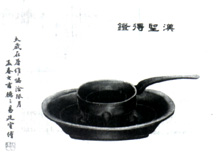
Illustration 38
Illustrations of Bronze Vessels & Deng汉圣得镫.
YI TINGXUAN易廷宣 (active late nineteenth century).
tzu DE SAN 德三.
Album leaf.
Ink on silk, 37.0 x 46.0 cm.
Dated 1859. Inscribed and signed with 1 seal.
[Former] registration number: AL11-12.
In: [SC: OPLCM. M], p.62, I T'ING HSÜAN ref. no 2 [plate 15].

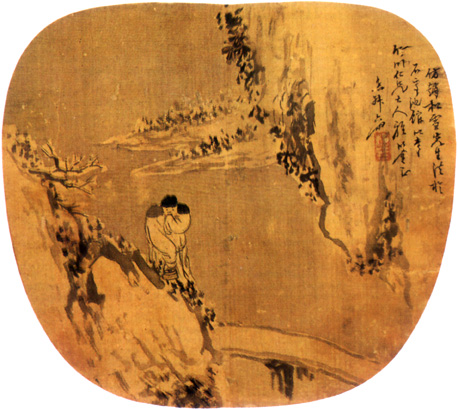
Figure in a Snow Scene in the Style of Zhao Mengfu. 仿赵松雪雪景人物.
SU LIUPENG 苏六朋 (active mid nineteenth century).
tzu ZHEN QIN 枕琴, hao ZEN DAO REN 怎道人.
Fan [mounted on an album].
Album leaf. Colour on silk, 36.0 x 32.0 cm.
Inscribed and signed with 1 seal.
[Former] registration number: AL3.
In: [HC: KPLCM. M], p.46, SU LIU-P'ENG ref. no73 [not illustrated].
NOTES
1 LI Tan 李旦. , Bada Shanren congkao «八大山人丛考» (Collected Studies on Bada Shanren), in "Wenwu" «文物» ("Cultural Relics"), (7) 1960.
2 CHU Shengzhai 朱省斋, Shuhua suibi «书画随笔» (Essays on Calligraphy and Painting), Singapore, Shijie shuju 世界书局 World Publishing House, [1960?], p.33.
3 XIE Zhiliu 谢志枊, Zhu Da «朱耷», Shanghai 上海, Remin meishu chubanshe 人民美术出版社 The People's Fine Arts Publishers, 1958.
4 ZHOU Shixin 周士心, Bada Shanren nianpu «八大山人年谱›>, in "Meishu xuebao" «美术学报» ("Fine Arts Journal"), Taibei台北, Zhongguo huaxuehui chuban 中国画学会出版 Published by the China Painting Society, (4) 1969; ZHOU Shixin 周士心, Bada Shanren jiqi yishu «八大山人及其艺术» (Bada Shanren: The Artist and His Art), Taibei 台北, Yishu tushu kongzi chuban 艺术图书公司出版 Published by the Arts Books Company, 1974 - The author changed the year of the artist's death to 1705, thus making it even closer to the estimate by Xie Zhiliu.
5 XIE Zhiliu 谢志枊, Beixing suojian shuhua suoji «北行所见书画琐记» (Notes on Calligraphy and Painting During a Journey to the North), in "Wenwu" «文物»("Cultural Relics"), (10) 1963; XIE Zhiliu 谢志枊, Gonggu chuanqi xiesheng ce yu Bada Shanren zaoqi zuopin «故宫传綮写生册与八大山人早期作品» (Early Works of Bada Shanren in the National Palace Museum), in INTERNATIONAL SYMPOSIUM ON CHINESE PAINTING, National Palace Museum, Taiwan 台湾, 1970 [oral communication] & For Wang Fangyu's theory.
6 YE Zhou 叶舟, Guangyin ren zhuan «广印人传» (Stone Seal Carvers), juan 13 ― Where the author lists Wan Shouqi 万寿祺; HUANG Binhong 黄宾虹 DENG Shi 邓实, eds., "Meishu" congshu «美术丛书» "Fine Arts" Series, ed., vol.2, no 2 & For Yinshuo «印说» (On Stone Seals) (1 juan) by Wan Shouqi.
7 SUN Yunjin 孙运锦, Wan Shouqi zhuan«万寿祺传» (The Biography of Wan Shouqi), in LUO Zhenyu 罗振玉, ed., "Wan Nianshao xiansheng nianpu" «万年少先生年谱» ("A Chronology of Wan Nianshao")& As an appendix.
WAN Shouqi, U '0, R, Mobiao «墨表» (A Listing of Ink Sticks) (with an appendix, Lunmo «论墨» (On Ink Sticks)) - A book on antique ink sticks. See: "Cuilangganguan" congshu «翠琅玕馆丛书» "Cuilangganguan" Series, ed., vol.64; "Moshu" [congshu] «墨书[丛书]» "Ink Sticks" [Series], ed., vol.2, no 2) & Both works make reference to Mobiao «墨表» (A Listing of Ink Sticks). Also see: SUN Yunjin 孙运锦. Wan Shouqi 万寿祺 (Wan Shouqi), vol. 1 & Where this Lunmo «论墨»appears as Molun «墨论» [ideograms in reverse order].
9 Nine of these pieces are listed below in chronological order:
1) "Meiren yichuang tu" 美人倚窗图 ("A Young Woman seen through the Window of a Pavillion"), dated 1631, album leaf painted in gongbi 工笔. Belongs to The British Museum collection, London.
2) "Chishan meiren tu" 持扇美人图 ("Lady With a Fan"), dated 1642, album leaf. Reproduced in Shenzhou guoguang ji «神州国光集» (The National Glory a/China), 19[??], vol.1.
3) "Gaosong youcen tu" 高松幽岑图 ("Tall Pines and Steep Hills"), dated 1646, a scroll painted on silk, now in a Japanese collection, in Kansai. See: BENRIDO, Paintings of the Ming and Ching Dynasties, Kyoto, 1967, plate 67; SUMIGAWA Shioten, Catalogue of Ming and Qing Paintings in Hashimoto Sueyoshi Collection, Tokyo, 1972, plate [ill.] 62 & For a reproduction of this painting.
4) "Qiujiang biesi tu" 秋江别思图 ("Farewell on the Autumn River"), annotated handscroll painted on paper. See: "Yilin" congshu «艺林丛书» "The Art" Series, ed., Xianggang 香港 Hong Kong, Commercial Press, 1974, vol.10, p. 190 & Although an illustration of this painting has not yet been published, according to this publication it belongs to the Zhejiang Museum collection, in the People's Republic of China.
5) "Zihua xiang" 自画象 ("Self Portrait"), undated and present location unknown. See: TUAN Shih [?], Wan Shouqi zihuaxiang «万寿祺自画象» (Wan Shouqi's Self Portrait), in "Yilin" congshu «艺林丛书» "The Art" Series, ed., op. cit., vol. 10 & Where this work is mentioned.
6) An illustration of the artist's studio, caotang 草堂, dated 1651, composed by four units executed on paper mounted together on a handscroll format, now in the Musée Guimet collection, in Paris.
7) An album of landscapes and flowers in eighteen leaves, dated 1650, now in the Princeton University Art Museum collection.
8) "Muyang tu" 牧羊图 ("A Shepherd and His Sheep"), in the Luis de Camões Museum collection.
9) "Kumu shian tu" 枯木石岸图 ("Bare Tree on a Rocky Shore"), a fan painting, signed but undated. See: SIREN, Osvald, Chinese Painting: Leading Masters and Principles, London - New York, 1956 -1958, 1958, vol.7 p.419 & According to the author, it is owned by Vannotti, in Lugano, Switzerland.
10 Idem.
FANG Wen 73 R, Fu Qingzhu nianpu «傅青主年谱» (Chronology of Fu Qingzhu), Taibei 台北, Zhonghua shuju 中华书局 Zhonghua Books Co., 1970.
12 The most important of these societies were the following three:
1)Pinghuashe 萍花社 (The Waterwed Blossoms Society) (1907-1908) founded by Qian Huian钱慧安, Wu Zonglin 吴宗麟, Wang Li 王礼 and others. It was replaced by a new society, Yuyuan 予园 (Yuyan Society) and Qian Huian became a member. Later he succeded Yang Yi 杨逸 and Gao Yong 高邕 as chairman of that society.
2)Wanmishanfang 宛米山房 (The Wanmi Mansion) [Studio] founded in 1909 by Chen Shichi 陈石痴, Wang Kun 汪琨,Zhu Wenhou 朱文候, Qian Xuehe 钱雪鹤 and others. In 1910, Wang Kun and some other members formed the Shanghai shuhua yanjiuhui 上海书画研究会(Shanghai Calligraphy and Painting Society).
3)Qingyiguan 青漪馆(The Green Ripple Pavilion) [Studio] founded in 1911, the last yer of the Qing dynasty, by Hu Tanqing 胡郯卿, Hong Shuru 洪庶如 and others.
13 Xu Beihong 徐悲鸿, CHEN Zhichu 陈之初, ed., Ren Bonian pingzhuan «任伯年评传»(A. Biography and Critical Appraisal of Ren Bonian's Works), Singapore, 1953 [?] [reprinted in: "Daren" «大人», Xianggang 香港 Hong Kong, Daren chubanshe 大人出版社 The Great Men Publishers, (36) April 1973]
14 ZHUANG Shen 庄申, Guangdong lidai mingjia huihua «广东历代名家绘画>> Some Observations on Kwangtung Paintings, in "[Guangdong huace]""广东画册 " "Kwangtung Painting", [Exhibition Catalogue], Xianggang 香港 Hong Kong, City Museum & Art Gallery, 1973.
15 An album of ten landscape paintings is also known. Nine of the paintings are in the collection of Charles A. Drenowatz, in Zurich, Switzerland; the tenth painting being in the Ping Shan Museum平山博物馆 collection, University of Hong Kong.
See: LI Zhujin, A Thousand Peaks and Myriad Ravines: Chinese Paintings in the Charles A. Drenowatz Collection, Ascona, 1974, vol.2. - For the illustrations of the nine paintings belonging to this collection.
* Former Lecturer at the Department of Chinese, University of Hong Kong, Hong Kong.
Note: Unless otherwise stated all following illustrations are reproduced from: SHEN, Chuang [Zhuang], PART II: & Other Chinese Paintings in the Luís de Camões Museum, Macau, in CHAN, Helen, "A Catalogue of Chinese Paintings in the Luis de Camoes Museum: Macau", Macau, Imprensa Nacional, 1977 [The University of Hong Kong - Centre of Asian Studies Bibliographies and Research Guides, no 11(English)], pp.53-67 & abbreviated hereafter as [CS: OCPLCM. M ].
start p. 229
end p.